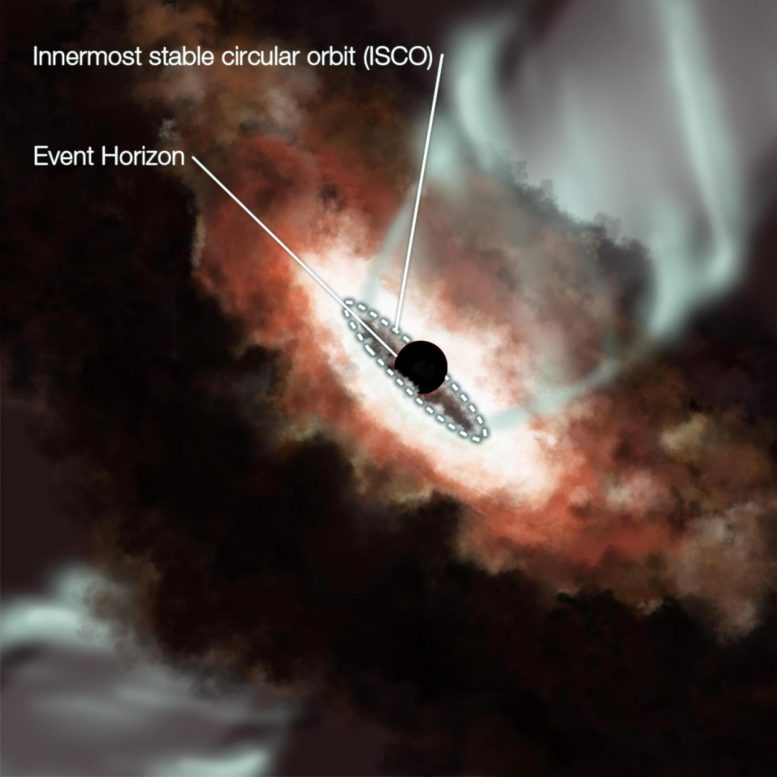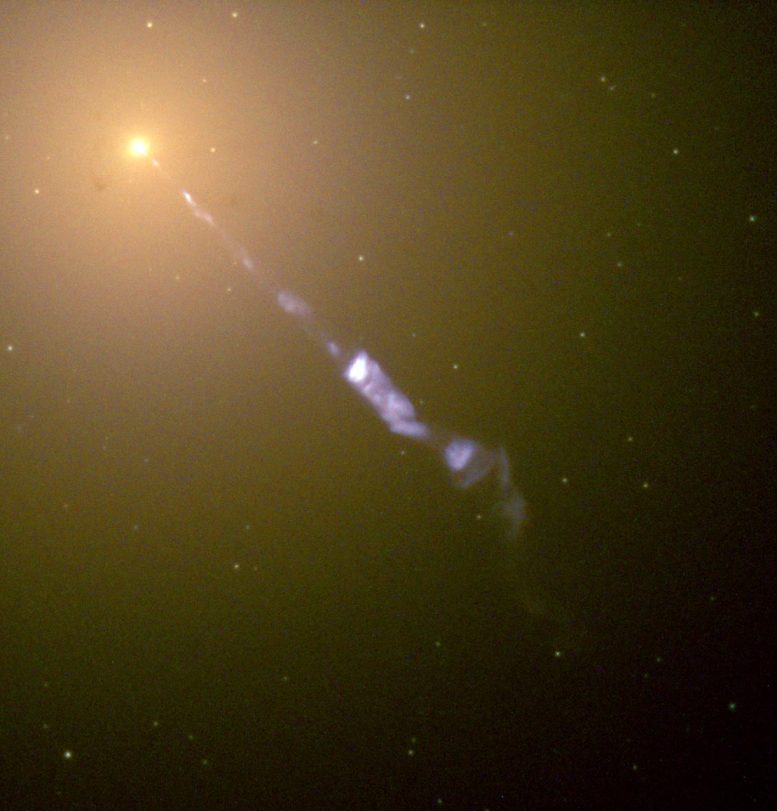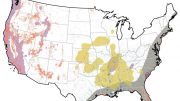
This artist’s conception shows the region immediately surrounding a supermassive black hole (the black spot near the center). The black hole is orbited by a thick disk of hot gas. The center of the disk glows white-hot, while the edge of the disk is shown in dark silhouette. Magnetic fields channel some material into a jet-like outflow – the greenish wisps that extend to upper right and lower left. A dotted line marks the innermost stable circular orbit, which is the closest distance that material can orbit before becoming unstable and plunging into the black hole. Credit: Chris Fach (Perimeter Institute & University of Waterloo)
For the first time, international team of astronomers has measured a black hole’s “point of no return,” the closest distance that matter can approach before being irretrievably pulled into the black hole.
Using a continent-spanning telescope, an international team of astronomers has peered to the edge of a black hole at the center of a distant galaxy. For the first time, they have measured the black hole’s “point of no return” — the closest distance that matter can approach before being irretrievably pulled into the black hole.
A black hole is a region in space where the pull of gravity is so strong that nothing, not even light, can escape. Its boundary is known as the event horizon.
“Once objects fall through the event horizon, they’re lost forever,” says lead author Shep Doeleman, assistant director at the MIT Haystack Observatory and research associate at the Harvard-Smithsonian Center for Astrophysics (CfA). “It’s an exit door from our universe. You walk through that door, you’re not coming back.”
The team examined the black hole at the center of a giant elliptical galaxy called Messier 87 (M87), which is located about 50 million light-years from Earth. The black hole is 6 billion times more massive than the sun. It’s surrounded by an accretion disk of gas swirling toward the black hole’s maw. Although the black hole is invisible, the accretion disk is hot enough to glow.
“Even though this black hole is far away, it’s so big that its apparent size on the sky is about the same as the black hole at the center of the Milky Way,” says co-author Jonathan Weintroub of the CfA. “That makes it an ideal target for study.”
According to Einstein’s theory of general relativity, a black hole’s mass and spin determine how close material can orbit before becoming unstable and falling in toward the event horizon. The team was able to measure this innermost stable orbit and found that it’s only 5.5 times the size of the black hole’s event horizon. This size suggests that the accretion disk is spinning in the same direction as the black hole.

Streaming out from the center of the galaxy M87 like a cosmic searchlight is one of nature’s most amazing phenomena, a black-hole-powered jet of electrons and other sub-atomic particles traveling at nearly the speed of light. In this Hubble telescope image, the blue jet contrasts with the yellow glow from the combined light of billions of unseen stars and the yellow, point-like clusters of stars that make up this galaxy. Lying at the center of M87, the monstrous black hole has swallowed up matter equal to 2 billion times our Sun’s mass. M87 is 50 million light-years from Earth. Credit: The Hubble Heritage Team (STScI/AURA) and NASA/ESA
The observations were made by linking together radio telescopes in Hawaii, Arizona, and California to create a virtual telescope called the Event Horizon Telescope, or EHT. The EHT is capable of seeing details 2,000 times finer than the Hubble Space Telescope.
The team plans to expand its telescope array, adding radio dishes in Chile, Europe, Mexico, Greenland, and the South Pole, in order to obtain even more detailed pictures of black holes in the future.
The work is published in the journal Science.
Reference: “Jet-Launching Structure Resolved Near the Supermassive Black Hole in M87” by Sheperd S. Doeleman, Vincent L. Fish, David E. Schenck, Christopher Beaudoin, Ray Blundell, Geoffrey C. Bower, Avery E. Broderick, Richard Chamberlin, Robert Freund, Per Friberg, Mark A. Gurwell, Paul T. P. Ho, Mareki Honma, Makoto Inoue, Thomas P. Krichbaum, James Lamb, Abraham Loeb, Colin Lonsdale, Daniel P. Marrone, James M. Moran, Tomoaki Oyama, Richard Plambeck, Rurik A. Primiani, Alan E. E. Rogers, Daniel L. Smythe, Jason SooHoo, Peter Strittmatter, Remo P. J. Tilanus, Michael Titus, Jonathan Weintroub, Melvyn Wright, Ken H. Young and Lucy M. Ziurys, 27 September 2012, Science.
DOI: 10.1126/science.1224768









Be the first to comment on "Astronomers Measure a Black Hole’s “Point of No Return”"